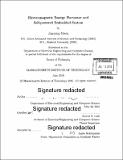Electromagnetic energy harvester and self-powered embedded system
Author(s)
Moon, Jinyeong
DownloadFull printable version (27.14Mb)
Other Contributors
Massachusetts Institute of Technology. Department of Electrical Engineering and Computer Science.
Advisor
Steven B. Leeb.
Terms of use
Metadata
Show full item recordAbstract
Energy harvesting offers an important design option for creating sensing and control elements without a requirement for custom wiring or batteries. The independent and care-free nature of energy harvesting enables monitoring devices to penetrate wider and deeper into our daily lives, making accommodation of fine sensing and control for condition-based maintenance ever more feasible. Finer granularity in sensing and control, which is the future of energy efficiency, alone is an immense benefit as it can reduce time and cost associated with a potential repair. Combined with condition-based maintenance, it can prevent potential down-time of a machine under monitoring. An exciting possibility creates a "self-powered" embedded system with an integrated energy harvester for electromechanical diagnosis. This non-intrusive energy harvester is designed to extract energy from magnetic fields around a power line of a load, in the manner of a current transformer. In contrast to the conventional usage of magnetic elements, such as transformers and inductors, the analysis on this "current transformer" reveals a critical result: for any given core for any particular application, power harvest is maximized when the core is permitted to saturate at an opportune time in the line cycle. The design of this integrated energy harvester is fully explored in the thesis, including: development of new models to incorporate a fully saturating magnetic core for simulation; designs of power electronics circuits for maximizing power harvest; and integration of the harvester into the embedded system as a practical power supply. The design of a self-powered and low-power embedded system, vibration assessment monitoring point with integrated recovery of energy (VAMPIRE), is discussed in depth in the thesis. The overall architecture of the embedded system is first presented, followed by designs of individual subsystems, the power package and the sensor package. In the power package, initialization, energy buffer, power interfaces, power regulation, and microcontroller design are explored. In the sensor package, power budget, sensors, data storages, storage management, wireless communication, and corresponding user interfaces are explored. Finally, impedance spectroscopy for an electromechanical load is discussed. Using the electrical and vibrational data that are nonintrusively collected from electromagnetically self-powered embedded system, structural issues of the load, i.e., changes in the stiffness of mounts and the imbalance of a shaft, can be clearly identified, making it feasible for this self-powered embedded system to be used for condition-based maintenance.
Description
Thesis: Ph. D., Massachusetts Institute of Technology, Department of Electrical Engineering and Computer Science, 2016. Cataloged from PDF version of thesis. Includes bibliographical references (pages 289-293).
Date issued
2016Department
Massachusetts Institute of Technology. Department of Electrical Engineering and Computer SciencePublisher
Massachusetts Institute of Technology
Keywords
Electrical Engineering and Computer Science.